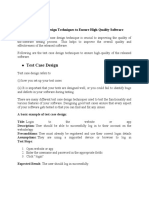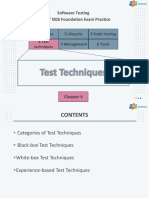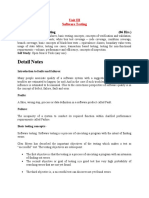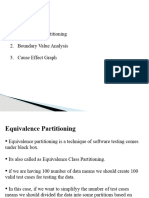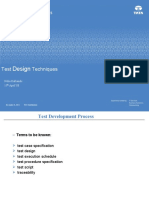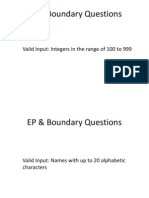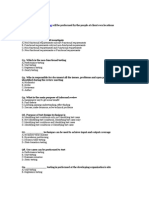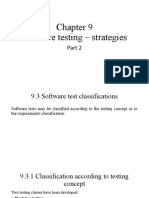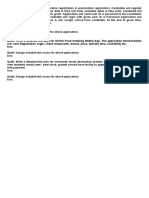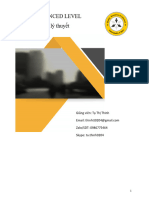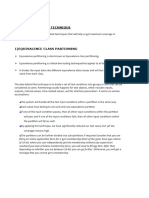Multiple Choice Questions: 1. Can help check condition coverage. a. Pattern b. Requirement c. Specification d. None 2.
Which technique is not specification-based a. Path testing. b. !oundar" value anal"sis. c. #quivalence partitioning. d. State transition testing. $. What is a graphical representation of inputs and the associated outputs effects %hich can be used to design test cases a. &isuali'ation b. Cause Effect Graph c. (se Case d None ). *efining and testing for combinations of conditions a. +ath ,esting b. Decision table testing c. (se-case testing d. Cause-effect graphing -. *ecision tables can be used as checklists for a. Scripted b. Unscripted c. !oth d. None testing.
.. Coverage for black-bo/ testing is usuall" determined based on coverage of the a. Specification b. Require ents. c. ,esting. d.a0c 1. Which testing is commonl" used %hen testing embedded soft%are a. +ath testing. b. !oundar" value anal"sis. c. #quivalence partitioning. d. !tate transition testing. 2. Which method is used to deal %ith large number of combination of parameter a. +ath testing b. !&3 c. "rthogonal arra# d. State transition
�4. +rovide a graphical representation of combinations of conditions to be tested. a. &isuali'ation b. Cause #ffect 5raph c. (se Case d. Classification tree 16. Which technique coverage is determined b" coverage of various defined path. a. Use case b. +ath c. State transition d. None 11. +artition is al%a"s e/ist %ith a. 7nput b. 8utput c. $oth d. None 12. !&3 onl" %orks on %hich partition. a. "rdered b. (nordered c. !oth d. None %ill in the blan&s: 1. 'esting techniques are the core of the test anal"st9s and technical test anal"st9s %ork focus. 2. Specification-based test techniques derive the test cases from soft(are require ent specification. $. *on9t overlook the in)alid partitions %hen testing the valid partitions. ). !&3 onl" %orks on ordered partition. -. When looking at the condition: %e have to consider relationship bet%een the condition as %ell as an" constraints. .. Decision tables help clarif" condition combination. 1. Coverage for black-bo/ testing is usuall" determined based on coverage of the require ents. 2. State diagram help )isuali*ation for the tester. 4. 7+; stands for input para eter odel. 16. Classification trees provide a graphical representation of combinations of conditions to be tested. 11. Use cases are scenarios that depict actual usage of the soft%are in the customer environment. 12. Use cases are oriented to%ard transition rather than functional areas. 1$. 8ne !oundar" %e need at least test the on condition and out condition. .
�'rue or %alse: 1. +artitions are limited to range :%alse 2. #+ can significantl" reduce the numbers of tests needed: 'rue $. Never trust a user to sta" on the primar" path.: 'rue ). (se cases are onl" valuable if the" reflect realistic usage scenarios.: 'rue -. !igger is better for orthogonal arra"s: at least in terms of test case increasing. :%alse .. State diagrams<tables help visuali'ation for the tester. :'rue 1. *ecision tables help clarif" state combinations. :%alse 2. !oundar" value anal"sis onl" %orks on ordered partitions. :'rue 4. +artitions e/its in man" places save testing time b" finding them :'rue 16. #quivalence partitions significantl" reduce the numbers of tests needed. :'rue 11. *on9t overlook the invalid partitions %hen testing the valid partitions. :'rue 12. +artition is al%a"s e/ist %ith input :%alse
